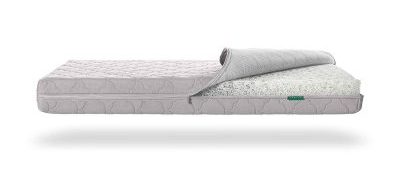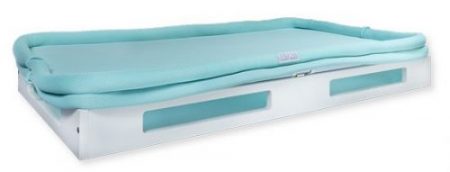Shopping Considerations for Crib Mattresses
When comparing mattress models for a child’s crib, here are a few key factors to consider.
Mattress Size
According to the U.S. Consumer Product Safety Commission (CPSC), mattresses used in cribs must be at least 27 1/4 inches wide and 51 1/4 inches long, and must also measure no more than six inches thick. CPSC standards also call for mattresses that snugly fit inside the crib with little to no space on the sides so babies aren’t able to become trapped.
Cover
Also known as the ticking, the cover is the outermost layer of material on a mattress. Some crib mattresses feature waterproof covers made from vinyl or polyethylene, either single- or multi-layer, which are ventilated to prevent a buildup of leakage when accidents occur. Other covers are made from cloth fabrics like cotton; these are not usually waterproof, but covers with nylon layers offer more fluid resistance. Be sure to check the cover for certification labels. Some vinyl materials may contain phthalates, or plasticizers, which can be harmful to a child’s health. A high-quality mattress should be phthalate-free.
Support
To reduce the risk of SIDS, babies should sleep on their backs because it’s easiest to breathe in this position. Infants placed to sleep on their stomachs are also at a higher risk of suffocation. A supportive mattress helps babies remain on their backs, while mattresses that lack sufficient support may lead to the child rolling onto his or her stomach.
Firmness
Firmness is another mattress factor that impacts the risk of SIDS. Firmer mattresses are considered the safest option for infants. Softer mattresses that conform to the baby’s body may lead to them sinking too deeply and/or rolling over and potentially suffocating. Soft mattresses may be more suitable for toddlers who have more control over their movements. Some mattresses sold today offer different firmness levels on each side of the mattress, typically a firmer side for infants and a softer side for toddlers.
Weight
Models that are on the heavier side may be more difficult to remove from the crib for cleaning or changing the sheet. Most crib mattresses weigh less than 20 pounds. Foam mattresses tend to be the lightest, followed by innersprings.
Edge Support
Some crib mattresses lack reinforced support along the edges. This can cause the edges to sink when a young child rolls over, which elevates the risk of physical injury, as well as suffocation. It can also be dangerous for little ones who like to stand at the edge of their cribs. For these reasons, shoppers should not only make sure their mattress snugly fits inside the crib, but also that the edges don’t sink too deeply.
Breathability and Temperature Regulation
Overheating is a leading cause of SIDS, so it’s important for parents to look out for mattresses that help control body temperature. Temperature regulation is often tied to how breathable the mattress materials are, particularly in the cover. Cloth covers, for example, retain more heat than vinyl covers. However, cloth tends to be more breathable, though many vinyl covers are perforated or aerated to make them more breathable.
Noise
Vinyl covers for crib mattresses may produce squeaking sounds when the child rolls around, which can lead to sleep disruptions. Cloth covers tend to be much quieter. By the same token, foam mattresses are fairly quiet compared to spring-based mattresses.
Ease of Cleaning and Resisting Stains
Because accidents do happen, a mattress with a washable cover and core is generally recommended. Multi-layered vinyl or polyethylene covers can help resist leaks and stains, and removable cloth covers can be washed. A mattress that resists stains and is easy to clean can be helpful for parents and also create a more sanitary sleeping space for the child.
Price
The price-point of a crib mattress may vary by mattress type, but generally speaking these models are priced much lower than standard-sized mattresses. Foam crib mattresses, for example, are often priced lower than $100, while innerspring crib mattresses typically cost between $75 and $150. Crib mattresses made of natural or organic materials are usually more expensive—as much as $300 to $400, in some cases. The cover material may also impact price; vinyl covers are often more expensive since they are considered more breathable and easier to clean than cloth covers.
Odor
Most mattresses emit smells known as off-gassing when they are removed from their original packaging. These odors can be unpleasant, but they usually dissipate within a day or two, especially in well-ventilated rooms. Foam mattresses tend to produce more off-gassing than innersprings. However, crib mattresses are designed to emit minimal odor, and they must be certified as such (see next entry).
Certification of Materials
Crib mattresses may be certified in multiple areas. All models should be GREENGUARD Gold-certified for minimal emissions of volatile organic compounds (VOCs); Greenguard Gold certification applies to VOCs, as well as other chemical components that carry health risks. Additionally, foam mattresses should be CertiPUR-US certified. This designation ensures that the foam doesn’t contain certain materials, such as formaldehyde or lead. Crib mattresses sold as “organic” should be Global Organic Textile Standard (GOTS) certified, as well.
SIDS and Crib Mattress Selection
SIDS is the unexplained death of an infant, usually during sleep, so it’s a major consideration when shopping for a crib mattress. SIDS claims the lives of nearly 2,000 newborns and infants each year, and is one of the leading causes of death in the U.S. for children between the ages of one month and one year. While specific causes are unknown, there are certain factors that put babies at a higher risk.
According to the Mayo Clinic, the following groups are among the most vulnerable:
- Babies with brain defects, particularly defects in areas of the brain that regulate breathing and wakefulness.
- Babies with low birth weights; in most cases, their brains are not mature enough to regulate healthy breathing and heart rates.
- Babies with respiratory infections and other issues that affect breathing.
In addition to health factors, some environmental factors can also make babies more vulnerable to SIDS.
- Babies who sleep on their stomachs are at a higher risk of suffocating, and those who sleep on their sides may roll onto their stomachs. Back-sleeping is considered the safest position for babies.
- Babies who sleep on soft mattresses. In the event that they roll onto their stomachs, a softer surface makes them more vulnerable to suffocation. This is why firm crib mattresses are universally recommended.
- Babies who share a bed with their parents, a sibling or a pet. The risk of SIDS is much lower for babies who sleep in the same room as their parents but in their own cribs.
- Babies who become overheated.
The Mayo Clinic lists additional risk factors for SIDS.
- Male infants are more likely to die of SIDS than female infants.
- Most SIDS cases are for babies between two and four months of age.
- Babies are at a higher risk for SIDS if one or more of their siblings or cousins has died of SIDS.
- Secondhand smoke puts babies at a higher risk of developing SIDS.
Fortunately, parents can help reduce their baby’s risk of developing SIDS by exercising the following precautionary measures:
- Always make sure babies are put to sleep on their backs. After one year, when babies can move around more easily, they may be able to sleep on their stomachs.
- A bare, firm mattress is best. Parents should avoid placing their babies on thick, soft blankets or quilts. Also make sure the crib is clear of other objects, such as stuffed animals, that can cause breathing problems if the baby presses his or her face against them.
- Proper temperature regulation is critical. Babies need to be warm enough in their cribs, but overheating can also lead to SIDS. If it’s cold, dress your baby in layers so you can always remove one. Use a sleep sack instead of loose blankets, and never cover your baby’s head or face.
- Parents should set up their baby’s crib or bassinet in their bedroom for at least six months, if not a year. However, babies should never sleep in their parents’ beds.
- Breastfeeding babies for at least six months can reduce their risk of developing SIDS. Additionally, babies who suck on a pacifier are also at lower risk for SIDS, although parents should wait until the baby is at least three weeks old and nursing well.
- The Mayo Clinic notes “some evidence” that immunizing babies can reduce their risk for SIDS, and there is no evidence than any immunizations increase their risk of developing SIDS.




